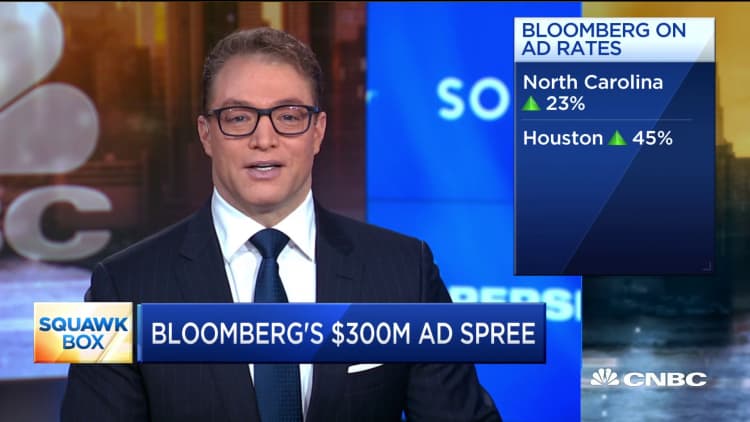
Mike Bloomberg's ad-buying spree may be rankling his fellow Democrats and President Donald Trump, but local broadcasters are loving it.
Bloomberg is worth about $60 billion and is self-funding his campaign to be president. The former three-term New York mayor has spent more than $250 million on TV and radio ads and $45 million to $50 million on digital — more than twice that spent by Trump and all the other Democratic candidates combined, according to Advertising Analytics and Acronym.
Following the Iowa caucuses — in which former South Bend, Indiana, Mayor Pete Buttigieg and Sen. Bernie Sanders finished ahead after a counting process riddled with inconsistencies — Bloomberg's campaign announced plans to double its spending.
All that spending has created a windfall for local TV broadcasters, especially in Bloomberg's top target states — California, Texas, Florida, New York and Pennsylvania. California and Texas hold their primaries on March 3, aka Super Tuesday. Florida holds its primary March 17, while New York and Pennsylvania hold theirs April 28.
Shares of publicly traded companies that own local broadcasters have also risen, a welcome surprise for an industry that's being eroded by digital media. Shares of Nexstar Media Group, the largest of the local broadcasting companies, are up over 20% since news of Bloomberg's run broke in late November. Shares of Gray Television are up about 10%.
Broadcast companies "are jazzed to have Bloomberg in the fray," wrote Wells Fargo analyst Steven Cahall. "His spending has caused a meaningful uptick in Q4 political revenue vs. company plans."
Cahall said total political-ad spending in the 2020 elections on broadcast could top $3.5 billion, up 11% from 2016 and a new record. In 2016, both Hillary Clinton and Trump spent less than broadcasters expected. Trump favored digital advertising and didn't need to spend on broadcast, and Clinton's campaign felt confident it didn't need a larger TV-ad blitz.
This time, the combination of Trump's massive war chest, Bloomberg's intention to spend at least $1 billion and a drawn-out Democratic primary could give a lift to the entire broadcast industry and its shareholders.
"When politicians go to war, own the arms dealers," Cahalll wrote in a recent report.
Perhaps the biggest beneficiaries will be Nexstar and Sinclair. Nexstar, based in Irving, Texas, bought Tribune Media Company last year and now has stations in many of Bloomberg's top markets. Bloomberg has spent $36 million in California, his top market, according to Advertising Analytics. Nexstar owns and/or operates eight stations in California, while Sinclair owns and/or operates 13.
In Texas, where Bloomberg has spent $30 million, Nexstar has 27 stations and Sinclair has 16. In Florida, where Bloomberg has spent $27 million, Sinclair has 13 stations, while Gray has five and Nexstar has three.
'One-time shock'
Granted, some analysts say the Bloomberg effect will be temporary and that broadcasters will continue to suffer from a structural shift away from TV to digital.
"This is a one-time shock to the system, and it helps," said Rich Greenfield, partner at LightShed Partners, a tech, media and telecom research firm. "Certainly these huge numbers are going to be very helpful. But remember, the election ends in November, and then we are back to the business of normal, which is dramatic declines in live-TV viewing."
Still, the unexpected influx of Bloomberg cash can help many of the broadcasters pay down the mountain of debt they've taken on after years of consolidation, which will help cushion them against future declines. With many about to report earnings and guidance, analysts say the broadcasters could also wind up using the Bloomberg windfall to pay special dividends, invest in their growing news operations or buy out other stations.
Bloomberg's cash — for better or worse — is also raising ad rates for other advertisers in certain markets, which will have a cascading, broader effect. That means that candidates of both parties running for Congress, governor or local races may also have to pay more, along with car dealers, restaurants and other more traditional advertisers.
According to Advertising Analytics, television-ad rates jumped 45% in Houston after the Bloomberg campaign purchased an ad blitz in November. In North Carolina, Democratic hopeful Tom Steyer was paying $400 for one spot during a weekday local news broadcast before Bloomberg entered the race. After Bloomberg jumped in, Steyer had to pay $450 for the same spot.
"Amid this huge spending spike," said Advertising Analytics, "North Carolina broadcasters are clearly responding like rational market actors by raising rates for all candidates when Bloomberg spends. Higher spending tends to lead to higher rates statewide in a surprisingly tidy relationship."


